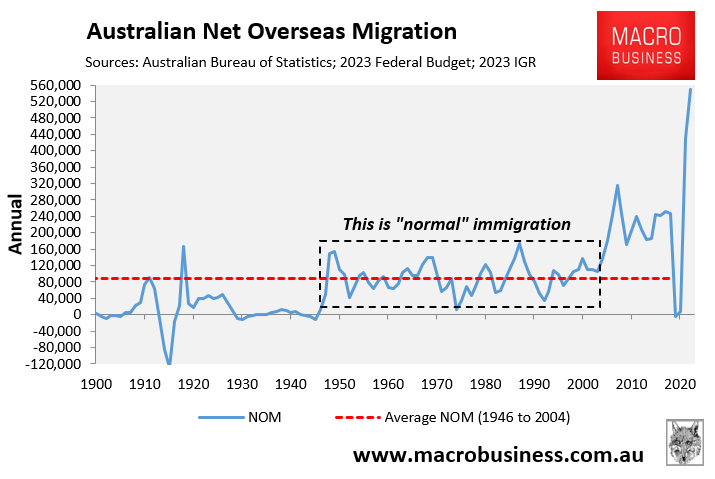It is a strange turn of events that only two marginal economists in a country of 27 million people make sense.
It has something to do with declining Australian brain cells fed on a diet of social media and partisan poison. Let’s not go into that.
Rather, let’s consider Australia’s only two major policy problems and the exceedingly obvious solutions that nobody wants to touch.
The first is immigration.
Current levels of people flows are far in excess of the political economy’s capability to cope.
Argue all you want about the solutions to crush-loaded housing, infrastructure, health, education, and all public services.
The simple fact of the matter is that cutting immigration to historical levels of around 100,000 per annum (which is still generous) will resolve all of the issues.

Sure, there will be some casualties. The growth in federal budget tax receipts will slow a little. But not very much given wages will grow faster and bracket creep will work its baleful magic. That will help lift per capita GST receipts as well.
Also, if we have less of the growing warm bodies easy path to higher tax receipts, Canberra will be forced to return to tax reform, most notably for resources.
In addition, cutting immigration will instantly fix decimated state budgets, as they can stop the bottomless pit of building roads and railways to nowhere. Thus, the holistic fiscal situation of the nation will improve in total.
The second policy change to fix everything is East Coast domestic gas reservation for the export cartel.
If Canberra were to apply a blanket 15% reservation policy or, even better, an export levy upon every tonne of LNG exported above $6Gj, the flow-on effects for the local economy would be immense.
The energy transition would be immediately back on track. Instead of nuclear onanism, cheap and easy gas peakers would substitute coal boilers within two years.
Security of supply for firming power would unstop an avalanche of renewable investment. We would immediately be on track to meet the Paris Agreement emission reduction targets.
Moreover, gas and power prices would collapse to $6Gj and $40MW/h. We’d go from having the most expensive energy in the world to some of the cheapest.
Inflation would evaporate and the Australian dollar would crash. Manufacturing would stabilise and then grow without any need for wasted public subsidies.
Australians would also collect billions in gas tax revenues currently given away to foreign-owned corporations.
All by themselves, cutting immigration and smashing the gas export cartel would instantly ease congestion in infrastructure, save the health system, and reorient the education system towards pedagogy over scamming Third World youth.
As interest rates fell, it may result in house prices rising for a while. But it would cure rents as building construction surged above demand and input costs tumbled with energy amid lower demand.
Eventually, house prices would roll and become cheaper as the immigration demand pump was switched off permanently.
These two policy changes, possible to enact in two minutes, will all but fix Australia.

